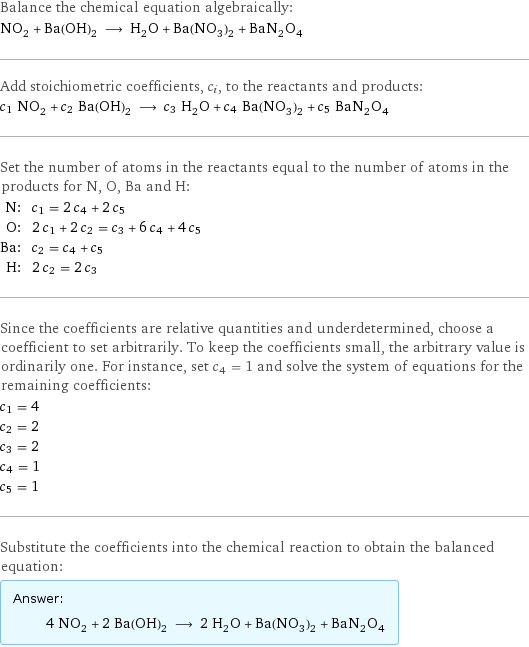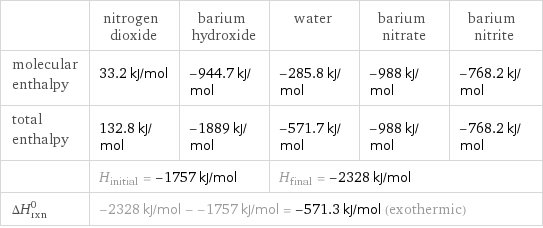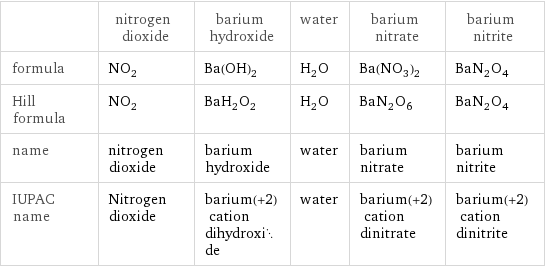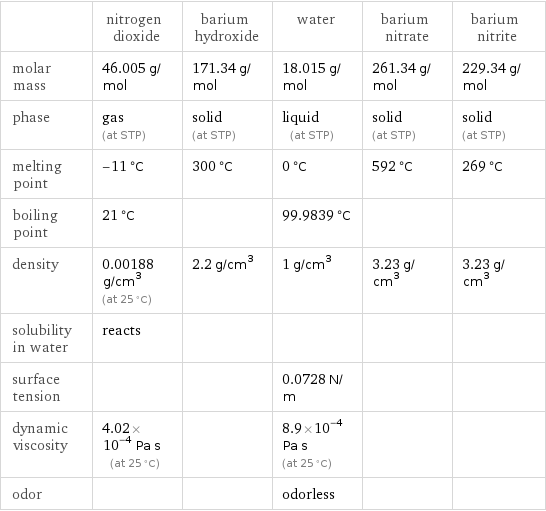Input interpretation

NO_2 nitrogen dioxide + Ba(OH)_2 barium hydroxide ⟶ H_2O water + Ba(NO_3)_2 barium nitrate + BaN_2O_4 barium nitrite
Balanced equation

Balance the chemical equation algebraically: NO_2 + Ba(OH)_2 ⟶ H_2O + Ba(NO_3)_2 + BaN_2O_4 Add stoichiometric coefficients, c_i, to the reactants and products: c_1 NO_2 + c_2 Ba(OH)_2 ⟶ c_3 H_2O + c_4 Ba(NO_3)_2 + c_5 BaN_2O_4 Set the number of atoms in the reactants equal to the number of atoms in the products for N, O, Ba and H: N: | c_1 = 2 c_4 + 2 c_5 O: | 2 c_1 + 2 c_2 = c_3 + 6 c_4 + 4 c_5 Ba: | c_2 = c_4 + c_5 H: | 2 c_2 = 2 c_3 Since the coefficients are relative quantities and underdetermined, choose a coefficient to set arbitrarily. To keep the coefficients small, the arbitrary value is ordinarily one. For instance, set c_4 = 1 and solve the system of equations for the remaining coefficients: c_1 = 4 c_2 = 2 c_3 = 2 c_4 = 1 c_5 = 1 Substitute the coefficients into the chemical reaction to obtain the balanced equation: Answer: | | 4 NO_2 + 2 Ba(OH)_2 ⟶ 2 H_2O + Ba(NO_3)_2 + BaN_2O_4
Structures

+ ⟶ + +
Names

nitrogen dioxide + barium hydroxide ⟶ water + barium nitrate + barium nitrite
Reaction thermodynamics
Enthalpy

| nitrogen dioxide | barium hydroxide | water | barium nitrate | barium nitrite molecular enthalpy | 33.2 kJ/mol | -944.7 kJ/mol | -285.8 kJ/mol | -988 kJ/mol | -768.2 kJ/mol total enthalpy | 132.8 kJ/mol | -1889 kJ/mol | -571.7 kJ/mol | -988 kJ/mol | -768.2 kJ/mol | H_initial = -1757 kJ/mol | | H_final = -2328 kJ/mol | | ΔH_rxn^0 | -2328 kJ/mol - -1757 kJ/mol = -571.3 kJ/mol (exothermic) | | | |
Equilibrium constant
![Construct the equilibrium constant, K, expression for: NO_2 + Ba(OH)_2 ⟶ H_2O + Ba(NO_3)_2 + BaN_2O_4 Plan: • Balance the chemical equation. • Determine the stoichiometric numbers. • Assemble the activity expression for each chemical species. • Use the activity expressions to build the equilibrium constant expression. Write the balanced chemical equation: 4 NO_2 + 2 Ba(OH)_2 ⟶ 2 H_2O + Ba(NO_3)_2 + BaN_2O_4 Assign stoichiometric numbers, ν_i, using the stoichiometric coefficients, c_i, from the balanced chemical equation in the following manner: ν_i = -c_i for reactants and ν_i = c_i for products: chemical species | c_i | ν_i NO_2 | 4 | -4 Ba(OH)_2 | 2 | -2 H_2O | 2 | 2 Ba(NO_3)_2 | 1 | 1 BaN_2O_4 | 1 | 1 Assemble the activity expressions accounting for the state of matter and ν_i: chemical species | c_i | ν_i | activity expression NO_2 | 4 | -4 | ([NO2])^(-4) Ba(OH)_2 | 2 | -2 | ([Ba(OH)2])^(-2) H_2O | 2 | 2 | ([H2O])^2 Ba(NO_3)_2 | 1 | 1 | [Ba(NO3)2] BaN_2O_4 | 1 | 1 | [BaN2O4] The equilibrium constant symbol in the concentration basis is: K_c Mulitply the activity expressions to arrive at the K_c expression: Answer: | | K_c = ([NO2])^(-4) ([Ba(OH)2])^(-2) ([H2O])^2 [Ba(NO3)2] [BaN2O4] = (([H2O])^2 [Ba(NO3)2] [BaN2O4])/(([NO2])^4 ([Ba(OH)2])^2)](../image_source/57efc5e8c3c2459de3590870dba9a99c.png)
Construct the equilibrium constant, K, expression for: NO_2 + Ba(OH)_2 ⟶ H_2O + Ba(NO_3)_2 + BaN_2O_4 Plan: • Balance the chemical equation. • Determine the stoichiometric numbers. • Assemble the activity expression for each chemical species. • Use the activity expressions to build the equilibrium constant expression. Write the balanced chemical equation: 4 NO_2 + 2 Ba(OH)_2 ⟶ 2 H_2O + Ba(NO_3)_2 + BaN_2O_4 Assign stoichiometric numbers, ν_i, using the stoichiometric coefficients, c_i, from the balanced chemical equation in the following manner: ν_i = -c_i for reactants and ν_i = c_i for products: chemical species | c_i | ν_i NO_2 | 4 | -4 Ba(OH)_2 | 2 | -2 H_2O | 2 | 2 Ba(NO_3)_2 | 1 | 1 BaN_2O_4 | 1 | 1 Assemble the activity expressions accounting for the state of matter and ν_i: chemical species | c_i | ν_i | activity expression NO_2 | 4 | -4 | ([NO2])^(-4) Ba(OH)_2 | 2 | -2 | ([Ba(OH)2])^(-2) H_2O | 2 | 2 | ([H2O])^2 Ba(NO_3)_2 | 1 | 1 | [Ba(NO3)2] BaN_2O_4 | 1 | 1 | [BaN2O4] The equilibrium constant symbol in the concentration basis is: K_c Mulitply the activity expressions to arrive at the K_c expression: Answer: | | K_c = ([NO2])^(-4) ([Ba(OH)2])^(-2) ([H2O])^2 [Ba(NO3)2] [BaN2O4] = (([H2O])^2 [Ba(NO3)2] [BaN2O4])/(([NO2])^4 ([Ba(OH)2])^2)
Rate of reaction
![Construct the rate of reaction expression for: NO_2 + Ba(OH)_2 ⟶ H_2O + Ba(NO_3)_2 + BaN_2O_4 Plan: • Balance the chemical equation. • Determine the stoichiometric numbers. • Assemble the rate term for each chemical species. • Write the rate of reaction expression. Write the balanced chemical equation: 4 NO_2 + 2 Ba(OH)_2 ⟶ 2 H_2O + Ba(NO_3)_2 + BaN_2O_4 Assign stoichiometric numbers, ν_i, using the stoichiometric coefficients, c_i, from the balanced chemical equation in the following manner: ν_i = -c_i for reactants and ν_i = c_i for products: chemical species | c_i | ν_i NO_2 | 4 | -4 Ba(OH)_2 | 2 | -2 H_2O | 2 | 2 Ba(NO_3)_2 | 1 | 1 BaN_2O_4 | 1 | 1 The rate term for each chemical species, B_i, is 1/ν_i(Δ[B_i])/(Δt) where [B_i] is the amount concentration and t is time: chemical species | c_i | ν_i | rate term NO_2 | 4 | -4 | -1/4 (Δ[NO2])/(Δt) Ba(OH)_2 | 2 | -2 | -1/2 (Δ[Ba(OH)2])/(Δt) H_2O | 2 | 2 | 1/2 (Δ[H2O])/(Δt) Ba(NO_3)_2 | 1 | 1 | (Δ[Ba(NO3)2])/(Δt) BaN_2O_4 | 1 | 1 | (Δ[BaN2O4])/(Δt) (for infinitesimal rate of change, replace Δ with d) Set the rate terms equal to each other to arrive at the rate expression: Answer: | | rate = -1/4 (Δ[NO2])/(Δt) = -1/2 (Δ[Ba(OH)2])/(Δt) = 1/2 (Δ[H2O])/(Δt) = (Δ[Ba(NO3)2])/(Δt) = (Δ[BaN2O4])/(Δt) (assuming constant volume and no accumulation of intermediates or side products)](../image_source/a232b2befde90013ce238f60d7e12f03.png)
Construct the rate of reaction expression for: NO_2 + Ba(OH)_2 ⟶ H_2O + Ba(NO_3)_2 + BaN_2O_4 Plan: • Balance the chemical equation. • Determine the stoichiometric numbers. • Assemble the rate term for each chemical species. • Write the rate of reaction expression. Write the balanced chemical equation: 4 NO_2 + 2 Ba(OH)_2 ⟶ 2 H_2O + Ba(NO_3)_2 + BaN_2O_4 Assign stoichiometric numbers, ν_i, using the stoichiometric coefficients, c_i, from the balanced chemical equation in the following manner: ν_i = -c_i for reactants and ν_i = c_i for products: chemical species | c_i | ν_i NO_2 | 4 | -4 Ba(OH)_2 | 2 | -2 H_2O | 2 | 2 Ba(NO_3)_2 | 1 | 1 BaN_2O_4 | 1 | 1 The rate term for each chemical species, B_i, is 1/ν_i(Δ[B_i])/(Δt) where [B_i] is the amount concentration and t is time: chemical species | c_i | ν_i | rate term NO_2 | 4 | -4 | -1/4 (Δ[NO2])/(Δt) Ba(OH)_2 | 2 | -2 | -1/2 (Δ[Ba(OH)2])/(Δt) H_2O | 2 | 2 | 1/2 (Δ[H2O])/(Δt) Ba(NO_3)_2 | 1 | 1 | (Δ[Ba(NO3)2])/(Δt) BaN_2O_4 | 1 | 1 | (Δ[BaN2O4])/(Δt) (for infinitesimal rate of change, replace Δ with d) Set the rate terms equal to each other to arrive at the rate expression: Answer: | | rate = -1/4 (Δ[NO2])/(Δt) = -1/2 (Δ[Ba(OH)2])/(Δt) = 1/2 (Δ[H2O])/(Δt) = (Δ[Ba(NO3)2])/(Δt) = (Δ[BaN2O4])/(Δt) (assuming constant volume and no accumulation of intermediates or side products)
Chemical names and formulas

| nitrogen dioxide | barium hydroxide | water | barium nitrate | barium nitrite formula | NO_2 | Ba(OH)_2 | H_2O | Ba(NO_3)_2 | BaN_2O_4 Hill formula | NO_2 | BaH_2O_2 | H_2O | BaN_2O_6 | BaN_2O_4 name | nitrogen dioxide | barium hydroxide | water | barium nitrate | barium nitrite IUPAC name | Nitrogen dioxide | barium(+2) cation dihydroxide | water | barium(+2) cation dinitrate | barium(+2) cation dinitrite
Substance properties

| nitrogen dioxide | barium hydroxide | water | barium nitrate | barium nitrite molar mass | 46.005 g/mol | 171.34 g/mol | 18.015 g/mol | 261.34 g/mol | 229.34 g/mol phase | gas (at STP) | solid (at STP) | liquid (at STP) | solid (at STP) | solid (at STP) melting point | -11 °C | 300 °C | 0 °C | 592 °C | 269 °C boiling point | 21 °C | | 99.9839 °C | | density | 0.00188 g/cm^3 (at 25 °C) | 2.2 g/cm^3 | 1 g/cm^3 | 3.23 g/cm^3 | 3.23 g/cm^3 solubility in water | reacts | | | | surface tension | | | 0.0728 N/m | | dynamic viscosity | 4.02×10^-4 Pa s (at 25 °C) | | 8.9×10^-4 Pa s (at 25 °C) | | odor | | | odorless | |
Units
